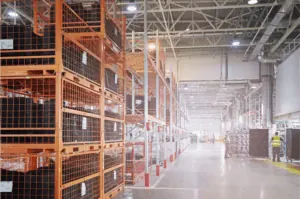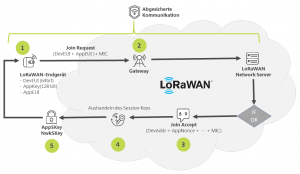In today's business world, sustainability and efficiency are essential pillars for a company's success. The Internet of Things (IoT) and technological innovations play a crucial role in reverse supply chain management. The IoT provides solutions to overcome operational challenges, optimize processes and increase profitability.

Introduction
In contrast to traditional supply chain processes, which focus on the manufacture and distribution of products, reverse supply chain management concentrates on returning products to the production cycle. This is achieved through reuse, recycling, repair or resale, thus making a significant contribution to environmental protection and the profitability of a company.
In this article, we examine how the Internet of Things (IoT) can help to optimize these processes in order to further increase both sustainability and profitability. We first look at the challenges in reverse supply chain management and then present suitable solutions.
Reverse supply chain management
Companies face numerous challenges when implementing the reverse supply chain. These include logistical obstacles, quality control, regulatory compliance and environmental impact. A comprehensive analysis and innovative solutions are required to address these aspects.
Problems with reverse supply chain management
- Logistical hurdles: In contrast to forward logistics, where products are delivered in large quantities to a small number of locations, reverse supply chain management is characterized by a large number of small and unpredictable returns. The challenge for companies is therefore to develop and ensure efficient systems for taking back, sorting and forwarding these items.
- Quality assurance: Another major challenge in the reverse supply chain is quality assurance. Returns often do not arrive at the company in perfect condition, which makes it difficult to reintegrate them directly into the production cycle. It is therefore crucial to develop effective procedures for reprocessing these items.
- Regulatory compliance: Compliance with legal regulations is another hurdle. In most countries, there are strict regulations regarding the return and disposal of certain products. In order to avoid penalties, reverse supply chain activities must comply with transnational regulations.
- Environmental impact: Last but not least, the reduction of environmental impact also plays a decisive role. The efficient reuse and disposal of products and materials can make a significant contribution to conserving natural resources and avoiding waste.
Impact on sustainability and profitability
The challenges listed in reverse supply chain management have a direct impact on the profitability and sustainability of companies. Logistical difficulties and inefficient processes can lead to an increase in operating costs, while a lack of quality assurance and non-compliance with regulatory requirements can result in financial risks and a loss of corporate reputation. In addition, inadequate environmental management can not only worsen the environmental balance, but also entail long-term economic risks.
Reverse supply chain solutions
To meet these challenges, companies are turning to various solutions in the field of reverse supply chain management. These include digitalization, process optimization, cooperation and customer participation. By using IoT , companies can achieve greater transparency in their reverse supply chain. Standardized processes also help to increase efficiency.
Working with specialized service providers enables companies to better meet complex regulatory requirements and achieve their sustainability goals. In addition, actively involving customers in reverse supply chain management has a positive effect by creating incentives. In the next section, however, we will look in particular at how IoT can be used as a solution.

Process optimization with IoT in the reverse supply chain
The Internet of Things has established itself as a key technology for optimizing reverse supply chain processes. By integrating IoT solutions, companies can achieve an unprecedented level of transparency and efficiency in their reverse supply chain processes.
- Predictive maintenance and quality assurance: The Internet of Things (IoT) enables real-time monitoring of the condition of products and components, which makes it possible to implement predictive maintenance strategies. Companies can detect problems at an early stage before failures occur, which increases the quality and reliability of remanufactured products.
- Better decision making: IoT improves decision making in reverse supply chain management through real-time data and advanced analytics. With up-to-date information on the condition and market value of returned products, more informed decisions can be made on whether to recycle, repair, reuse or sell them.
- More efficiency through data analysis: The volumes of data generated by IoT devices offer a wealth of analysis options. With the help of advanced data analysis methods, companies can identify patterns, make predictions and optimize processes to increase efficiency.
- Real-time monitoring: The ability of the Internet of Things (IoT) to enable real-time monitoring and control of returned products is another outstanding feature. IoT-Devices such as sensors or trackers provide detailed insight into the condition and location of products throughout the return process.
Significant cost savings through IoT in reverse supply chain management
The use of IoT can enable your company to make significant cost savings in reverse supply chain management. Real-time monitoring and analysis by IoT devices leads to considerable increases in efficiency in this area. By optimizing logistics processes, transport and storage costs can be reduced. In addition, the recycling and sale of materials can represent an additional source of income, particularly through optimized sorting of returns using IoT.
Communicating sustainability helps to improve the company's image in the eyes of its customers, which in turn leads to greater customer loyalty and more new customers. IoT also helps to avoid costly penalties due to compliance requirements and ensures competitiveness in a rapidly changing regulatory landscape in many markets.
Summary
By integrating IoT into reverse supply chain management, companies can overcome all key challenges and optimize processes. It provides unprecedented visibility and control over reverse processes, improves decision making through real-time data and data analytics, and supports efficient utilization of all resources. This will have an impact on both the sustainability and profitability of your business. If you are a decision maker in a company, now is the right time to invest in future-oriented IoT technologies. By making the switch early, you can also secure a competitive advantage.





